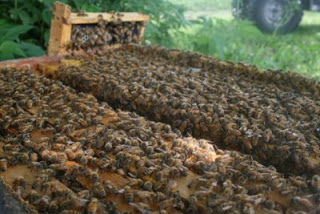Contributed by Dr. Dewey Caron
May and Memorial Day bracket this busy bee month. I start analyzing the pnwhoneybeesurvey responses this month, including those from SOBA members. Results will be posted as soon as I can get them gathered and analyzed. Thanks to all Southern Oregon beekeepers who filled in a survey!
In May, bee-wise, we have strong colonies, some (or most) that may begin swarm preparations. We also have new colonies started last month (or in early May) that need our attention. Colonies that survived winter should be strong and populous by May. Keeping such colonies from swarming remains one of our biggest challenges of spring management. Simply adding a box on top of existing brood boxes may help but anytime we add an extra brood box, or a super, we need to insure the bees begin to use the space.
 Expanding spring colonies get large and start raising queens (and drones) and then swarm for complex, inter-related reasons. Congestion of the brood nest (too many adult bodies on the brood frames), a rapidly expanding adult population, and an older queen, unable to supply sufficient queen substance to her daughters, are thought to be the major factors. For those extremely populous colonies, splitting can reduce mite numbers and halt swarm preparations. If done skillfully, the parent hive can remain strong and still store a surplus, while the splits, with some management, can be buildup (or later united) to successfully overwinter.
Expanding spring colonies get large and start raising queens (and drones) and then swarm for complex, inter-related reasons. Congestion of the brood nest (too many adult bodies on the brood frames), a rapidly expanding adult population, and an older queen, unable to supply sufficient queen substance to her daughters, are thought to be the major factors. For those extremely populous colonies, splitting can reduce mite numbers and halt swarm preparations. If done skillfully, the parent hive can remain strong and still store a surplus, while the splits, with some management, can be buildup (or later united) to successfully overwinter.
An uncomplicated method of splitting colonies is to select 2-3 frames of capped brood with some open brood, then shake the clinging bees back into the brood area. Put the frames of brood, looking among the few remaining stragglers to be sure you don’t have the colony queen, into a new box that you then place above the parent queenright colony above a queen excluder. Add a feeder frame (mixture of honey and bee bread, again shaking the clinging bees off them) and fill the box with drawn comb (or foundation frames). After a few hours (or next day), nurse-age bees will move from below (where you shook them) through the excluder onto the frames above but the queen will remain below.
Then lift the new box of bees off the parent colony and requeen with a caged queen (purchased), or a queen cell (from swarm cells) or allow the bees to raise a new queen via emergency (they will modify some worker cells into vertical queen cells). This last method is the least desirable alternative because it will be at least a month before the bees are queenright (i.e. have a mated, laying queen). If you add a purchased queen in a cage, your new split will be queenright in a few days; transferring a queen cell will result in a queenright colony in 2-3 weeks.
There are other methods to split, but this method is relatively easy to use and has a high degree of success. Try making up one or two splits this month – see if splitting “works” for you too.
It is the new colonies, such as these splits, that take most of our management attention in May. Besides splits, captured swarms, hived packages and new nucs all need attention. New queens need lots of space for egg laying. Brood areas stuck in one box slowly expand sideways. Thus splits (given mated queens), packages and nucs, need a second brood box in May, no later than 3-6 weeks from starting date. Be sure your bees expand into the new boxes, especially if all you have are foundation frames. Do not wait for them to fill out to the sides. Remember our European bees prefer to work upwards. Continue to feed in May as long as the bees are taking the syrup.
I wish all good spring management success!
